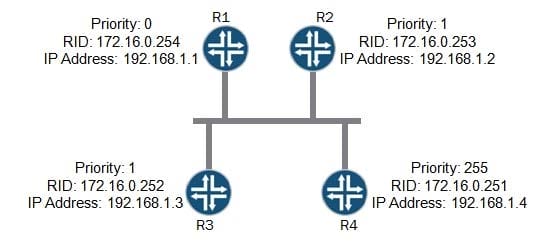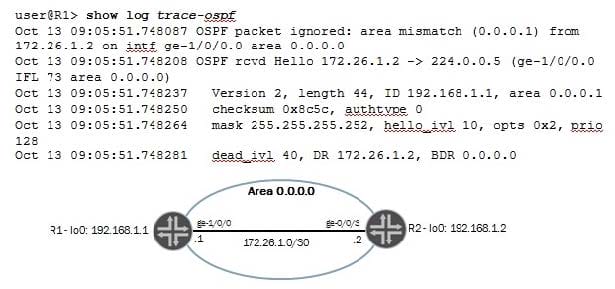Exam Details
Exam Code
:JN0-343Exam Name
:Juniper Networks Certified Internet Specialist (JNCIS-ENT)Certification
:Juniper CertificationsVendor
:JuniperTotal Questions
:563 Q&AsLast Updated
:Jun 04, 2025
Juniper Juniper Certifications JN0-343 Questions & Answers
-
Question 161:
You are asked to associate the v100 and v200 VLANs with the ge-0/0/1 interface. Which two configurations are correct? (Choose two.)
A. {master:0}[edit] user@switch# show interfaces ge-0/0/1 unit 0 { family ethernet-switching { vlan { members [ v100 v200 ]; } } }
B. {master:0}[edit] user@switch# show interfaces ge-0/0/1 unit 0 { family ethernet-switching { port-mode trunk; vlan { members [ v100 v200 ]; } } }
C. {master:0}[edit] user@switch# show vlans v100 { vlan-id 100; interface { ge-0/0/1.0; } } v200 { vlan-id 200; interface { ge-0/0/1.0; } }
D. {master:0}[edit] user@switch# show vlans v100 { vlan-id 100; l3-interface ge-0/0/1.0; } v200 { vlan-id 200; l3-interface ge-0/0/1.0; }
-
Question 162:
-- Exhibit -user@router> show configuration | no-more
...
interfaces {
ge-0/0/0 {
unit 0 {
family inet {
address 10.210.12.131/27;
}
}
}
ge-0/0/1 {
unit 0 {
family inet {
filter {
input fbf;
}
address 10.210.14.1/24;
}
}
}
}
firewall {
filter fbf {
term 1 {
then {
routing-instance fbf;
}
}
}
}
routing-instances {
fbf {
instance-type forwarding;
routing-options {
static {
route 0.0.0.0/0 next-hop 10.210.12.129;
}
}
}
}
user@router> show route
inet.0: 4 destinations, 4 routes (4 active, 0 holddown, 0 hidden)
+
= Active Route, - = Last Active, * = Both 10.210.12.128/27 *[Direct/0] 3d 23:21:02 > via ge-0/0/0.0 10.210.12.131/32 *[Local/0] 3d 23:21:17 Local via ge-0/0/0.0 10.210.14.0/24 *[Direct/0] 00:00:07 > via ge-0/0/1.0 10.210.14.1/32 *[Local/0] 00:00:07 Local via ge-0/0/1.0 -- Exhibit -What is causing the behavior shown in the exhibit?
A.
The software is ignoring the fbf routing instance because it uses a reserved name.
B.
The software is ignoring the default route in the fbf routing instance because there is no default route in the main routing instance.
C.
The software is not able to find an interface on the router configured with the 10.210.12.129 address.
D.
The software is not able to resolve the next hop of the default route in the fbf routing instance.
-
Question 163:
You want to configure interface ge-0/0/3 to transition to an inconsistent role in the blocking state when it receives a superior BPDU. Which command would you use?
A. set interfaces ge-0/0/3.0 no-root-port
B. set protocols rstp interface ge-0/0/3.0 root-protection
C. set protocols rstp interface ge-0/0/3.0 no-root-port
D. set interfaces ge-0/0/3.0 root-protection
-
Question 164:
In your network, you have configured an EX Series switch with port-based, VLAN-based, and router-based firewall filters. The filters are applied to examine all outgoing traffic. In which order will they be processed by the switch?
A. router, VLAN, port
B. VLAN, router, port
C. port, VLAN, router
D. router, port, VLAN
-
Question 165:

Referring to the exhibit, R1, R2, and R3 boot at the same time. Several minutes later, R4 boots. After R4 has been online for 40 seconds, which router will be the OSPF designated router?
A. R1
B. R2
C. R3
D. R4
-
Question 166:

You have two routers, R1 and R2, running OSPF in area 0. Router R1 is having problems with forming and adjacency with Router R2. Referring to the exhibit, which statement is correct about the OSPF configuration in the Router R1 trace output?
A. Router R1 has the wrong OSPF area configured.
B. Router R2 has the wrong OSPF area configured.
C. Router R1 has the wrong interface configured for OSPF.
D. Router R2 has the wrong interface configured for OSPF.
-
Question 167:
Which protocol is a link-state routing protocol?
A. BGP
B. RIP
C. OSPF
D. MPLS
-
Question 168:
Which statement describes a routing instance on a Junos device?
A. A routing instance provides separation of processing resources.
B. A routing instance provides control plane separation.
C. A routing instance virtualizes a Junos-based device, enabling it to run multiple copies of the Junos OS on the same system.
D. A routing instance is a unique collection of routing tables, interfaces, and routing protocol parameters.
-
Question 169:
-- Exhibit -[edit routing-options]
user@R1# show
static {
route 172.29.130.0/17 next-hop 172.30.25.1;
route 172.29.13.0/24 {
next-hop 172.30.25.1;
no-readvertise;
}
route 172.29.16.0/12 next-hop 172.30.25.1;
route 172.29.20.0/24 next-hop 172.30.25.1;
}
[edit protocols ospf]
user@R1# show
export Export_OSPF;
area 0.0.0.0 {
interface ge-0/0/2.0;
interface ge-0/0/3.0;
interface lo0.0;
}
[edit policy-options]
user@R1# show
policy-statement Export_OSPF {
term match-static-routes {
from {
protocol static;
route-filter 172.29.0.0/16 orlonger;
}
then accept;
}
}
-- Exhibit -Referring to the exhibit, there is an OSPF policy to redistribute static routes.
Which routes will be propagated to OSPF neighbors?
A. 172.29.130.0/17 172.29.13.0/24 172.20.16.0/12
B. 172.29.13.0/24 172.29.20.0/24
C. 172.29.130.0/17 172.29.13.0/24
D. 172.29.130.0/17 172.29.20.0/24
-
Question 170:
What are two considerations for determining the master router in VRRP? (Choose two.)
A. The router with a lower priority value.
B. The router with a higher priority value.
C. The router with the lowest IP address configured in the VRRP group.
D. Any router that has the no-preempt configuration option set.
Related Exams:
JN0-102
Internet Associate, Junos(JNCIA-Junos)JN0-104
Junos, Associate (JNCIA-Junos)JN0-105
Junos, Associate (JNCIA-Junos)JN0-1101
Juniper Networks Certified Design Associate (JNCDA)JN0-1103
Design, Associate (JNCIA-Design)JN0-130
Juniper networks Certified internet specialist.e(jncis-e)JN0-1301
Data Center Design, Specialist (JNCDS-DC)JN0-1302
Data Center Design Specialist (JNCDS-DC)JN0-1331
Security Design, Specialist (JNCDS-SEC)JN0-1332
Security Design, Specialist (JNCDS-SEC)
Tips on How to Prepare for the Exams
Nowadays, the certification exams become more and more important and required by more and more enterprises when applying for a job. But how to prepare for the exam effectively? How to prepare for the exam in a short time with less efforts? How to get a ideal result and how to find the most reliable resources? Here on Vcedump.com, you will find all the answers. Vcedump.com provide not only Juniper exam questions, answers and explanations but also complete assistance on your exam preparation and certification application. If you are confused on your JN0-343 exam preparations and Juniper certification application, do not hesitate to visit our Vcedump.com to find your solutions here.